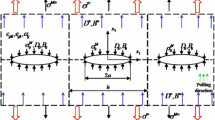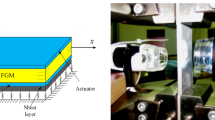We solve a boundary-value problem of magnetoelasticity for a piezomagnetic plane weakened by cracks. For this purpose, we generalize the method aimed at the solution of similar problems for anisotropic media. The boundary-value problem is reduced to a matrix singular integral equation and the solution of this equation is found in the class of vector functions unbounded at the ends of the notches. The numerical solution of this equation is obtained by the method of mechanical quadratures. The proposed numerical-analytic algorithm is used to investigate the influence of magnetoelastic fields on the stress intensity factors in the vicinity of the crack tips.




Similar content being viewed by others
References
A. E. Clark, Ferromagnetic Materials, North-Holland, Amsterdam (1980).
R. D. James and D. Kinderlehrer, “Theory of magnetostriction with application to Terfenol-D,” J. Appl. Phys., 76, No. 10, 7012–7014 (1994).
C.-B. Lin and C.-S. Yeh, “The magnetoelastic problem of a crack in a soft ferromagnetic solid,” Int. J. Solids Struct., 39, 1–17 (2002).
W.-Y. Tian and U. Gabbert, “Multiple crack interaction problem in magnetoelastic solids,” Eur. I. Mech. A. Solids, 23, 1–17 (2004).
S. A. Kaloerov, A. N. Baeva, and O. N. Boronenko, Two-Dimensional Problems of Electro- and Magnetoelasticity for Multiconnected Domains [in Russian], Yugo-Vostok, Donetsk (2007).
L. A. Fil’shtinskii, “Elastic equilibrium of a plane anisotropic medium weakened by arbitrary curvilinear cracks. Limiting transition to an isotropic medium,” Izv. Akad. Nauk SSSR. Mekh. Tverd. Tela, No. 5, 91–97 (1976).
W. F. Brown, Magnetoelastic Interactions, Springer, Berlin–Heidelberg–New York (1966).
W. Nowacki, Efekty Electromagnetyczne w Stalych Cialach Odksztalcalnych, PWN, Warsaw (1983).
J. F. Nye, Physical Properties of Crystals, Clarendon Press, Oxford (1957).
S. G. Lekhnitskii, Theory of Elasticity of Anisotropic Bodies [in Russian], Nauka, Moscow (1977).
N. I. Muskhelishvili, Singular Integral Equations [in Russian], Fizmatgiz, Moscow (1962).
N. P. Vekua, Systems of Singular Integral Equations, Noordhoff, Groningen (1967).
V. V. Panasyuk, Mechanics of Quasibrittle Fracture of Materials [in Russian], Naukova Dumka, Kiev (1991).
M. P. Savruk, Stress Intensity Factors in Bodies with Cracks [in Russian], Naukova Dumka, Kiev (1988).
E. I. Grigolyuk and L. A. Fil’shtinskii, Regular Piecewise Homogeneous Structures with Defects [in Russian], Fizmatlit, Moscow (1994).
Author information
Authors and Affiliations
Corresponding author
Additional information
Translated from Fizyko-Khimichna Mekhanika Materialiv, Vol. 51, No. 2, pp. 109–115, March–April, 2015.
Rights and permissions
About this article
Cite this article
Fil’shtyns’kyi, L.А., Nosov, D.M. & Eremenko, H.A. Plane Problem of Magnetoelasticity for a Piezomagnetic Medium with Cracks. Mater Sci 51, 267–275 (2015). https://doi.org/10.1007/s11003-015-9839-3
Received:
Published:
Issue Date:
DOI: https://doi.org/10.1007/s11003-015-9839-3




